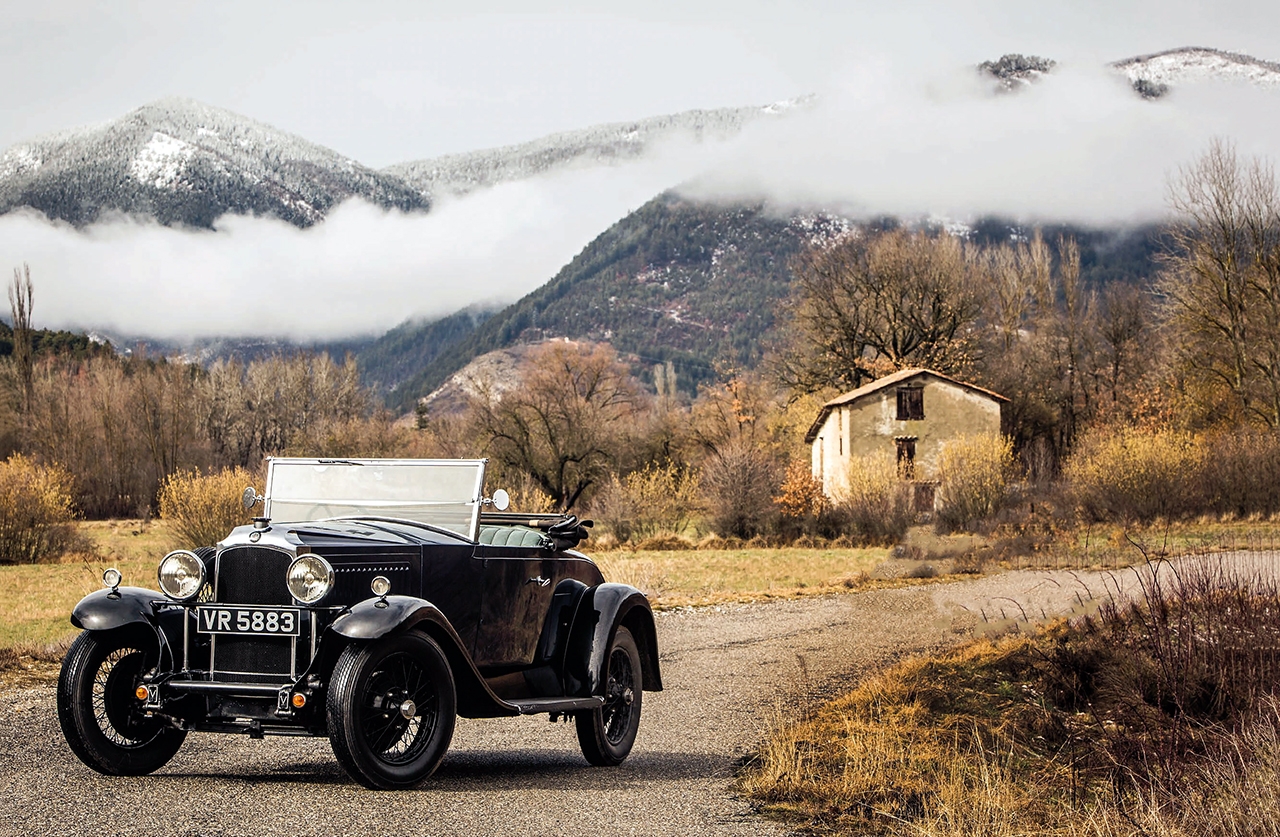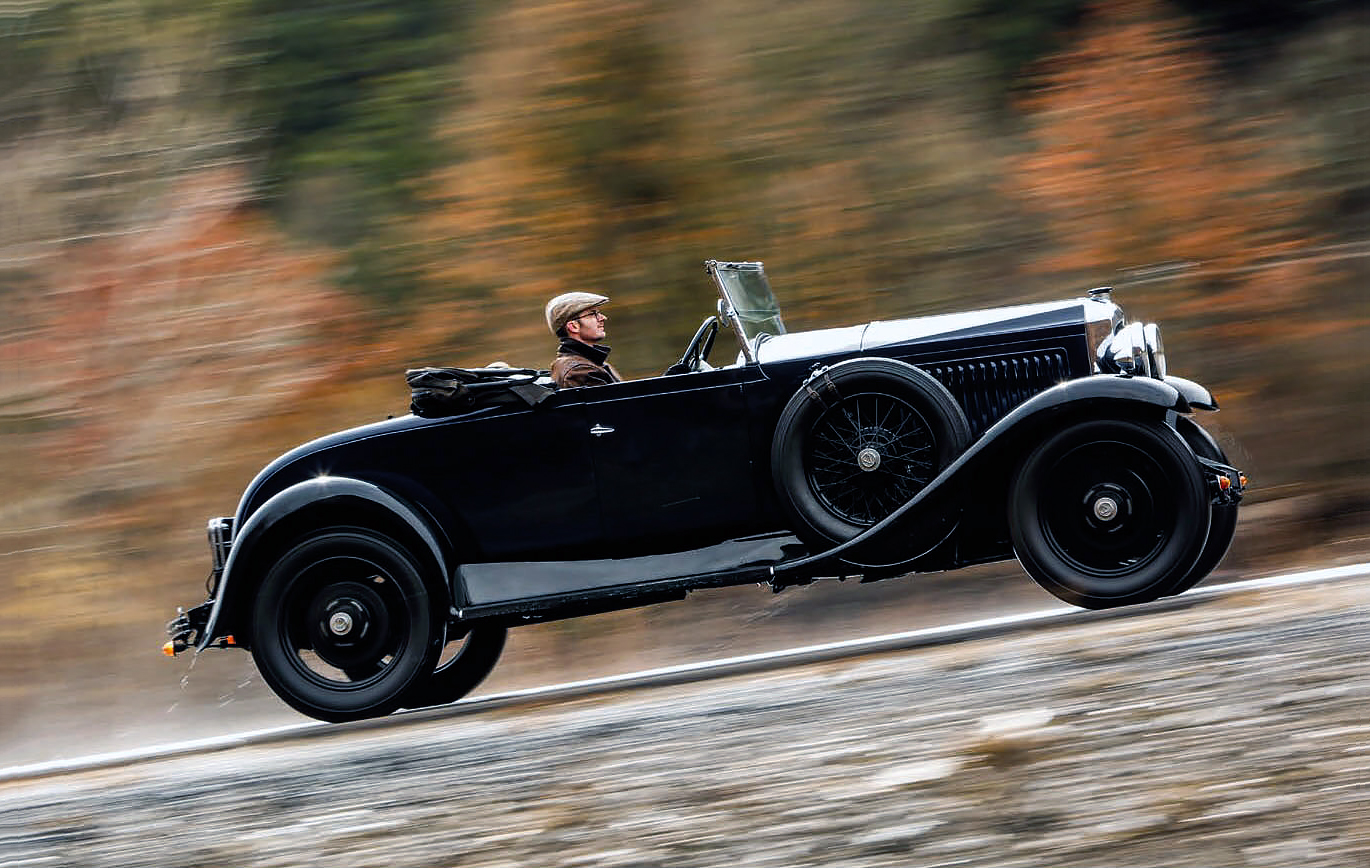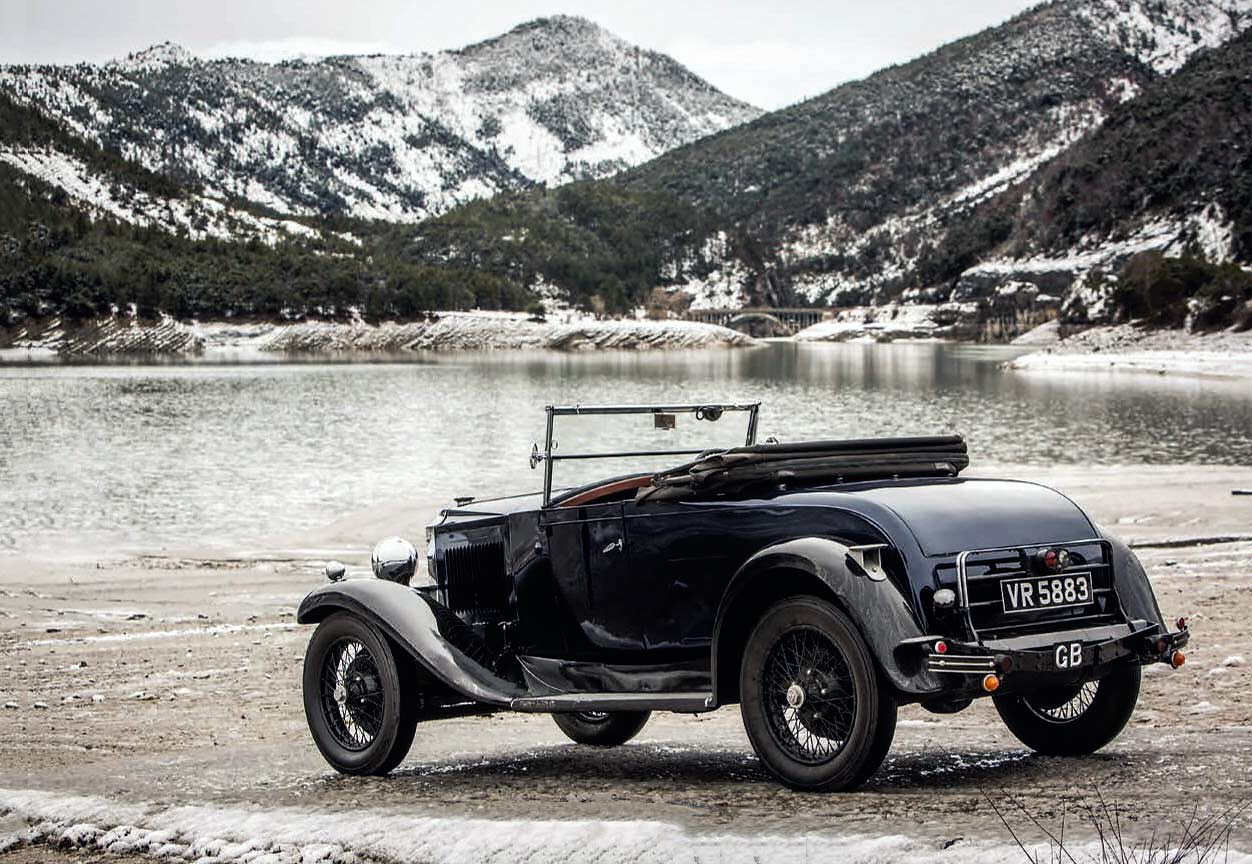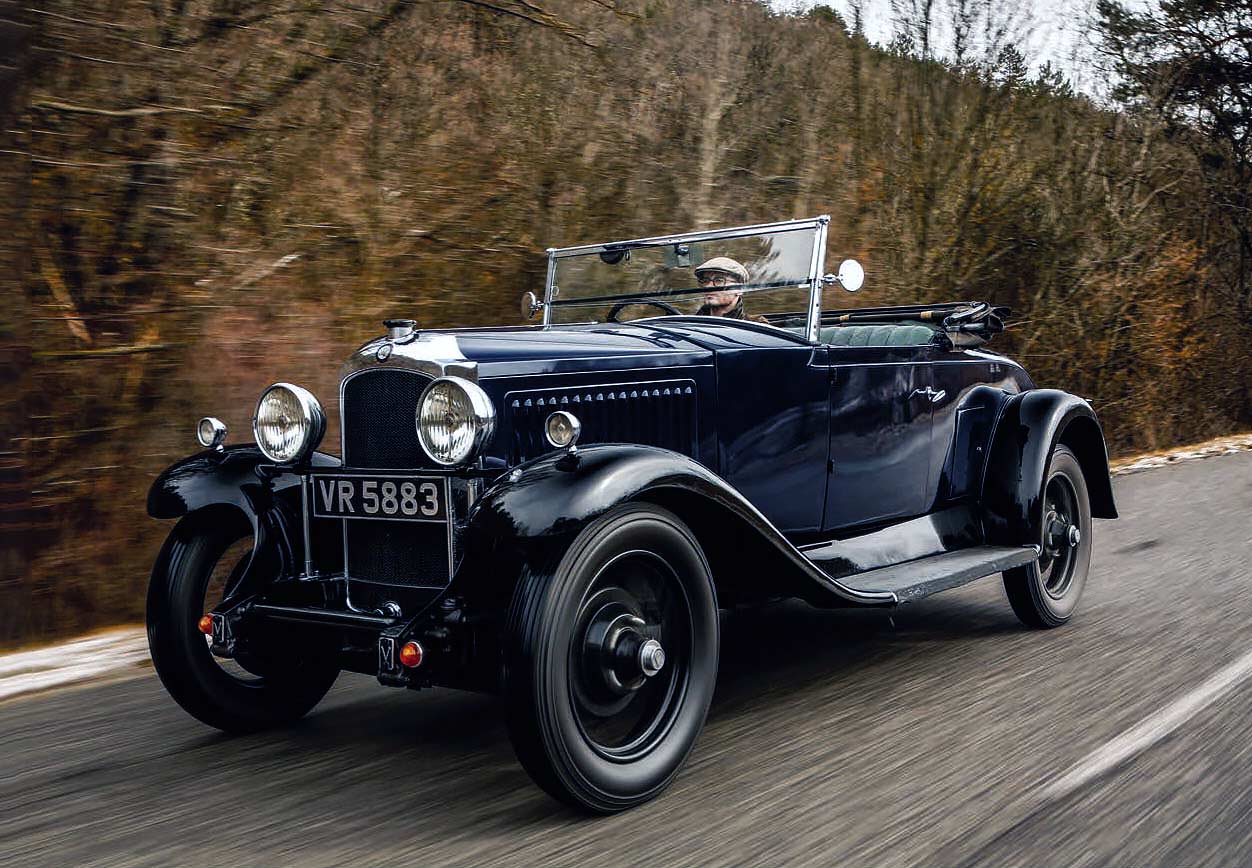
Vintage Alpine road trip Vauxhall 20-60 adventure. Vauxhall 20-60 road trip Grenoble or bust in a vintage T-type, the car that started Luton’s GM era. The Griffin’s unsung hero. Vauxhall’s 20-60 kept the firm going while General Motors decided what to do with its new acquisition. James Page heads for the mountains in a rare survivor. Photography Tony Baker/Vauxhall.
Darkness has fallen by the time we reach the outskirts of Grenoble. Alongside me aboard our Vauxhall T-type, and wrapped up to such an extent that only his eyes are visible, Baker looks more like a polar explorer than a photographer. It seems like a long time ago that we left Casino Square in Monte-Carlo, but now we just need to negotiate the final fewkilometres into town, where we’ve been promised warmth, food and a well-earned drink.
In front of us, the six-cylinder engine burbles away, as it has done all day. Its final job is to assist the impressive drums by keeping our speed in check down the seemingly endless descent; red lights flick on and off all around us, the drivers of modern cars not having to worry about anything as troublesome as brake fade.

Contrary to expectations, the headlamps are proving to be remarkably effective, even if they’re pointing more into the trees than the road. We’ve still got the roof down, too, which has become a badge of honour over the course of a gruelling day. That, and the fact that raising it simply means the cold air is more accurately channelled into your face.
Whichever way you look at it, 370km is quite a long way to drive, but not once did we doubt that the 86-year-old T-type would make it. Not even on the run over the Col de Toutes Aures, where the road climbed to more than 1100m. As the weather closed in, the mountains disappeared behind a veil of mist and the road beneath a covering of snow. With pine forests adding to the claustrophobic feel, the Vauxhall happily pressed on, never once stepping out of line or producing so much as a hiccup as we painstakingly followed the tracks of the car in front.
Rarely did our route straighten for any length of time and enable us to sit back and relax. It could have been worse, of course. In many places, the new road bypassed sharp corners and narrow bridges that earlier motorists would have had to contend with, but progress was slow – a fact brutally emphasised when the distance to Grenoble started appearing on the roadsigns and we didn’t seem to be getting any closer.

The view from the dicky seat as Page presses on towards Grenoble. The 20-60 is happiest cruising at 50-55mph. Far right, from top: compact profile of Melton coupé; 2916cc inline-six powerplant. Grosvenor was one of many firms to build T-type bodies.
Often, the route would be marked by a rockface to one side and a steep drop to the other, the deep exhaust note echoing back at us as we rumbled along at a steady 50mph. And yet the car’s super-direct steering inspires confidence, the set-up having not an ounce of play or wander.
The gearbox, too, is a definite improvement over earlier models. The long central lever has a relatively short throw, the only difficulty being in finding neutral on your way up or down the box. It’s remarkably easy to ‘bump’ into the next gear while you’re trying, but even if you don’t perfectly time your double-declutching, you’ll still find the next ratio, which is certainly not the case in, say, a 30-98. Make a mistake in that, and you will come to an embarrassing stop.
That was particularly important as we left Gap, the spectacular views of the receding town going largely ignored as we climbed and climbed and climbed, one hairpin after another requiring a rapid downchange from third to second. Having made a mess of countless changes while rolling through towns and not concentrating, it was a source of huge pride to silently nail each one when it really mattered – but that was nothing compared to the relief of reaching the summit and being able to once more hook the lever into top and leave it there.
For once, the Route Napoléon then briefly opened up and enabled us to make reasonable progress before it again began to climb towards Les Côtes-de-Corps, and on to La Mure. Even towards the end of a long and challenging day, the Vauxhall continued to pull itself out of hairpin after hairpin on an effortless wave of torque, and our spirits were buoyed by the fact that the distance to Grenoble was represented by double figures rather than triple.

The Vauxhall takes a breather after tackling the Col de Toutes Aures. T-type gained wire wheels; R-type used artillery ones.
Our faithful companion, the T-type, was produced during a time of great change for Vauxhall and was, logically enough, a development of the R-type. From its earliest days, the firm had been a prestigious manufacturer of topend motorcars, but despite the presence of its fabulous 30-98, the years following World War One were proving to be a struggle – as they were for many marques. The market had fundamentally changed, and the demand for hugely expensive cars that were built in tiny numbers was no longer enough to sustain many of the manufacturers that operated in such a way.
American companies had cottoned on to this, and produced cars in such vast quantities that they could be sold at a much cheaper price than their UK or European counterparts. To protect homegrown concerns, eye-watering tariffs were therefore imposed on US models, which meant that the likes of General Motors had to find an alternative route into this lucrative market.
GM’s first approach was to Austin, ironically one of the few established companies that was reacting to the needs of the mass market via its legendary Seven. When that fell through, it approached Vauxhall, which by then was in a parlous state and all too happy to sign up to the $2 ½ million deal. Talks with Austin stalled in early October 1925, negotiations with Vauxhall started on 21 October, and the deal was completed on 24 November. The rearranged board of directors contained four Brits and three Americans, but back in Detroit, the new overlords were still unsure about establishing an overseas manufacturing base – most of the key figures there wanted to find a way to simply export existing Stateside models.

The 20-60 is impressively stable and comfortable at cruising speeds, and doesn’t ‘wander’ as much as some pre-war cars.
It was against this backdrop of disagreement and prevarication that the R-type 20-60 – development of which had actually started before the takeover – was launched at the 1927 Olympia Motor Show. While the pre-GM 14-40 had been an attempt to broaden Vauxhall’s reach, this signalled a rather more wholesale change in that the range-topping 30-98 was no more. Following the expensive failure of the sleeve-valve 25-70, in fact, the 20-60 would become Luton’s only offering in those uncertain early days of American ownership.
Advertised as ‘The Six Super-excellent’, it was available from the factory as a £475 Princeton tourer or £495 Bedford saloon, or in chassis form for any number of coachbuilders to clothe – all came in at less than £1000. The overhead-valve ‘six’ grew from 2762cc to 2916cc in October 1928, at the same time that the chassis was strengthened, the steering ratio raised and the spring rates revised.
The model morphed into the T-type at the 1929 Olympia show. The new variant was offered in standard- or long-wheelbase form (10ft 3in and 10ft 10in respectively) and boasted further modifications. A mechanical fuel pump replaced the Autovac, the engine was mounted on rubber bushes and featured seven main bearings rather than nine, and there was a one-piece exhaust manifold. The chassis was further strengthened, too, and there was a choice of three rear-axle ratios. Longer springs were employed with hydraulic dampers, and one-shot lubrication was offered.
As you’d expect of a car that received myriad bodies from various coachbuilders, it seems as if there was a T-type for everybody. The six-light Richmond saloon was handsome but somewhat foreboding – the choice, no doubt, of the respectable pillar of society. The same goes for the neat Grosvenor four-light saloon, the Bedford saloon and the elegant Princeton tourer, which transported the likes of the future King Edward VIII and various nobles. Then there was the limousine that was used by government officials, including Ramsay MacDonald.
But there was something for the cad, too. The rakish Kingston Sportsman’s Coupé perhaps, or the Hurlingham Sports Roadster. Or even ‘our’ Melton Golfer’s Coupé, built by the Grosvenor Carriage Company and so named because of a hatch that could be opened to enable you to slide your golf clubs into the rear compartment. The reasoning must have been that opening the dicky seat and manhandling them over the top would have involved too much effort.
It was possible to have your Golfer’s Coupé in a rather extrovert variety of two-tone, the bonnet scoops painted to match the wings and running boards, but ours is a more restrained blue over black. It’s a neat, compact shape, the T-type gaining front wings that flowed more elegantly into the running boards compared to the basic items fitted to the R-type.

The 1000th 20-60, an R-type, rolls off the line at Luton. Artistic brochure proclaimed ‘a motor car of basic balance. Patinated leather covers hugely comfortable front seat. Nearside hatch enabled owners to slide golf clubs aboard.
Inside, there’s a soft, comfortable leather bench seat, with a ‘modern’ pedal arrangement – throttle to the right, brake in the middle – and the handbrake inside the body but down by your right leg. The stylish instrumentation is neatly housed in the centre of the wooden dashboard, the speedometer sharing space with an oil-level indicator, clock, ammeter and oil-pressure gauge. The controls for the lights, meanwhile, are handily positioned on the steering-wheel boss along with the advance/retard mechanism.
It’s easy to conjure an image of a young gentleman donning his plus-fours and driving down to Sunningdale for his regular Saturday-morning round, the Vauxhall cutting quite a dash in the car park amongst the Daimlers. And this would have been a car for the weekend golfer only. The notion of a ‘touring professional’ – distasteful to those who considered sport, even at the highest level, to be an amateur pursuit – was only just being explored by Walter Hagen in the New World. Most were still club professionals, faithful servants who had the status of tradesmen and who often weren’t allowed in the clubhouse. They certainly wouldn’t have been able to afford a car that cost roughly the same as a house, and three times the average annual wage.
Company records suggest that T-type production didn’t continue much beyond 1930, with the T80 replacing it in October 1931 after 1172 had been built. Although it was still an expensive car and retains much of the feel of a pre-GM Vauxhall, it paved the way towards a new beginning for the Luton company under its American owners. In many ways, it forms a bridge between the exclusive models of the early 1920s and the likes of the 2-litre Cadet, production of which started in 1930 and really marked Vauxhall’s entry into the mass-market.
After our adventure, Baker and I thaw out and sleep soundly. The next morning, the car will complete its journey to Geneva in time for the Salon de l’Automobile. We pack our stuff into a modern estate, but there’s still time to explain to the folk who’ll deliver it there how to operate the latch for the dicky seat and point out that the starter is operated via the floor-mounted button. To say that, no, the brakes are surprisingly good, and the only real difficulty is in finding neutral when double-declutching. As they leave in what feels like ‘our’ car, we note with disdain that they’ve put the hood up. Amateurs.
Thanks to everyone at Vauxhall Heritage.
‘THIS WAS STILLAN EXPENSIVE CAR, AND RETAINS THE FEEL OF A PRE-GM VAUXHALL’
‘THE 20-60 BECAME VAUXHALL’S ONLY OFFERING IN THOSE UNCERTAIN EARLY DAYS’
GM in Europe
In 1920, General Motors had established an assembly plant at Hendon, where it put together Cadillacs, Oaklands, La Salles and Buicks from CKD kits, as well as Chevrolet cars and trucks. With the taxation system penalising bigger cars, however, GM set its sights on acquiring a homegrown marque, a move that was part of a wider European strategy. In 1923, it had opened a Chevrolet plant in Copenhagen, and two years later another site followed in Belgium.
Over the next decade or so, it established further Chevrolet plants in Germany, Poland and Switzerland, and four years after taking over Vauxhall, it acquired Opel. The Vauxhall buyout also enabled GM to move production of Chevrolet-based commercial vehicles from Hendon to Luton. At first, they were called ‘Chevrolet Bedfords’, the former being dropped from 1931 onwards (below).





